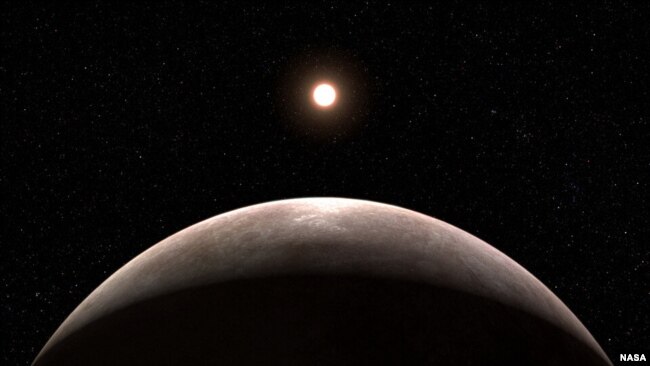太陽系外惑星の初確認
TESSが空の75%をカバーしているとは、驚き(一つ目の動画ない説明)です。
2番目のは、まさに映画を見ているような・・・I've got goosebumps.
研究者たちの興奮が伝わります!!
VOAで英語を学びましょう!!
NASAのウェッブ望遠鏡が初の太陽系外惑星を確認(和訳)
NASA’s Webb Telescope Confirms First Exoplanet
January 15, 2023
NASA のジェームス・ウェッブ宇宙望遠鏡は、太陽系外惑星を初めて確認しました。太陽系外惑星とは、太陽系外の星を周回する惑星のことです。
アメリカの宇宙機関は、この太陽系外惑星が地球とほぼ同じ大きさであるとしています。
メリーランド州にあるジョンズ・ホプキンス大学応用物理学研究所の研究者たちは、この確認のためにウェッブ望遠鏡が収集した新しいデータを調査しました。
NASAの別の望遠鏡による過去の観測は、太陽系外惑星が存在することを示すいくつかの証拠を提供していました。しかし、ウェッブの確認によって、この発見は公式なものとなりました。
もうひとつの宇宙望遠鏡は、Transiting Exoplanet Survey Satellite、TESS、と呼ばれています。TESSは、太陽系外の惑星を追加で発見する目的で2018年に打ち上げられました。
太陽系外惑星はLHS 475bと命名され、研究者によると、太陽系外惑星としてはかなり地球に近いということです。オクタンス座から約41光年の距離にあります。光年とは、光が1年で進む距離のことです。
太陽系外惑星は、望遠鏡で識別するのが難しいものです。その理由のひとつは、周回する星からの明るい光で隠れてしまうからです。そのため、恒星の光量が低下していることを観測し、惑星を探すのです。このような光量の低下は、惑星が恒星の前を通過することによって引き起こされる可能性があります。
研究者らは、ウェッブ望遠鏡は、通過観測という方法で太陽系外惑星の存在を確認することができたと言います。この確認は、ちょうど2回の通過の後、すぐに行われたと彼らは言います。
NASAは、ウェッブ望遠鏡は高いレベルの詳細な観測ができるように開発されたと述べています。赤外線を観測するための最新技術を搭載しています。この波は、人間の目では見ることができない電磁エネルギーの一種です。NASAは、この望遠鏡の観測装置は、ガスや塵の中から赤外線の波動を見つけ出し、遠くの天体を観測することができると言います。
ジェイコブ・ルスティグ=ヤーガー氏は、この研究の指導に協力しました。彼は声明で、望遠鏡のデータによって、「惑星がそこにあることは間違いない」とはっきりとした確認が容易にできたと述べています。
この発見は、最近ワシントン州シアトルで開催されたアメリカ天文学会の学会で発表されました。
チームのもう一人のリーダーであるケビン・スティーブンソン氏は、太陽系外惑星が小さく岩石質であるため、同定がより困難であることから、この確認は”impressive印象的”であると付け加えました。
NASAが運用する望遠鏡のうち、太陽系外惑星の大気に関する情報を収集できるのはウェッブだけです。しかし今回は、LHS 475bがどのような大気を持っているのかを確認するためのデータが十分でないと研究者たちは言います。
一般に、科学者たちはコンピュータモデルと望遠鏡のデータを使って、太陽系外惑星の大気を研究しています。研究チームのもう一人のメンバーであるエリン・メイ氏は、ウェッブ望遠鏡は一連の異なる分子を簡単に識別することができると述べています。「しかし、我々はまだ惑星の大気についてdefinitive conclusions決定的な結論を出すことはできません。」と彼女は付け加えました。
一方、研究者たちは、太陽系外惑星の大気に何が存在するかは確認できないが、何が存在しないかについては非常に確実であると述べます。たとえば、LHS 475b にメタンが大部分を占めるような厚い大気が存在するはずはないと、ルスティグ=ヤーガー氏は話します。
研究チームは、この太陽系外惑星がまったく大気をもたない可能性さえも指摘しています。いくつかのデータは、この太陽系外惑星が純粋な二酸化炭素の大気を持っている可能性を示唆しています。しかし研究者たちは、今後の観測でより多くのデータを集め、大気の状態を知るのに役立てようと考えていると言います。
NASAによると、これまでに5,000個以上の太陽系外惑星を確認していると言います。しかし、ルスティグ-ヤーガー氏は、ウェッブ望遠鏡は岩石質の小さな太陽系外惑星を発見するのに非常に優れた能力を備えていると指摘します。このことが、より多くの太陽系外惑星の確認につながる可能性があると彼は言います。
そして、ルスティグ-ヤーガー氏 は、「我々は、それらの大気がどのようなものであるかについて、やっと表面を削り始めたところです"」と付け加えました。
NASA’s Webb Telescope Confirms First Exoplanet
NASA’s James Webb Space Telescope has made its first confirmation of an exoplanet. An exoplanet is a planet that orbits a star outside our solar system.
The American space agency says the exoplanet is almost exactly the same size as Earth.
Researchers from the Johns Hopkins University Applied Physics Laboratory in Maryland examined new data collected by the Webb to make the confirmation.
Past observations made by another NASA telescope provided some evidence that the exoplanet existed. But the Webb’s confirmation made the discovery official.
The other space telescope is called the Transiting Exoplanet Survey Satellite, or TESS. TESS was launched in 2018 with the goal of discovering additional planets outside our solar system.
The exoplanet has been named LHS 475 b. The researchers said it is quite close to Earth for an exoplanet. It sits about 41 light-years away in the constellation Octans. A light-year is the distance light travels in one year.
Exoplanets are difficult for telescopes to identify. One reason is that bright light from the stars they orbit can hide them. The search process includes observing drops in the light level of stars. Such drops could be caused by a planet passing, or transiting, in front of a star.
Researchers said the Webb was able to confirm the existence of the exoplanet using the transiting observation method. They said the confirmation came quickly after just two transit events.
NASA has said the Webb telescope was developed to be able to provide a high level of detail in its observations. It is equipped with the latest technology to observe infrared waves. These waves are a kind of electromagnetic energy that cannot be seen with the human eye. NASA says the telescope’s instruments can find infrared waves through gas and dust to observe distant objects.
Jacob Lustig-Yaeger helped lead the research. He said in a statement that the telescope data made it easy to make a clear confirmation. “There is no question that the planet is there.”
The finding was recently presented at a conference of the American Astronomical Society in Seattle, Washington.
Another leader of the team, Kevin Stevenson, added that he found the confirmation “impressive” because the exoplanet is small and rocky, which makes identification more difficult.
Of all of NASA’s operating telescopes, only the Webb is equipped to collect information on the atmospheres of exoplanets. But in this case, the researchers said they do not have enough data to confirm what kind of atmosphere LHS 475 b has.
Scientists generally use computer models and telescope data to study the atmospheres of exoplanets. Another member of the research team, Erin May, said the Webb telescope can easily identify a series of different molecules. “But we can’t yet make any definitive conclusions about the planet’s atmosphere,” she added.
While the researchers said they cannot confirm what is present in the exoplanet’s atmosphere, they are very sure about what is not present. For example, LHS 475 b cannot have a thick atmosphere that is mostly methane, Lustig-Yaeger said.
The team even noted it is possible that the exoplanet has no atmosphere at all. Some of the available data suggests the exoplanet may have an atmosphere of pure carbon dioxide. But the researchers said they plan to gather more data in future observations to help them learn about atmospheric conditions.
NASA says it has so far confirmed more than 5,000 exoplanets. But Lustig-Yaeger noted that the Webb telescope is much better equipped to discover small, rocky exoplanets. He said this will likely lead to a lot more exoplanet confirmations.
And, Lustig-Yaeger added, “We have barely begun scratching the surface of what their atmospheres might be like.”
Words in This Story
impressive – adj. making a good or marked impression
definitive – adj. clear and not likely to change
conclusion – n. an opinion reached after considering all information about something
scratch the surface – idiom. to deal with only a small part of a subject or problem
